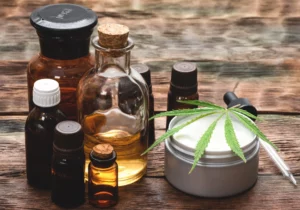Most foods and medications come with a sell-by or use-by date to let consumers know how long it’s safe to use. But cannabis products don’t always carry that kind of information, so people worry about how long cannabis can stay fresh, viable and safe to consume. Read on to learn more about whether or not cannabis products expire or go bad, and how to tell.
What happens if you use a product that’s way past its prime? The answer is complicated, as with many things related to cannabis. It depends on the kind of cannabis product you’re using and how it’s stored. Cannabis products can lose their potency over time, or “go bad” with harmful mold, fungus or bacteria. But when they’re stored properly, cannabis products can last up to a year or more. Read on to learn about the shelf life of your favorite cannabis products, and how to make them last as long as possible.
Article highlights
- Like other ingestible products, cannabis products can expire or go bad over time.
- Exposure to light, heat and moisture can cause cannabis products to degrade.
- Improper storage can cause cannabis to develop toxins such as mold, or cause chemical changes that alter effectiveness.
- Production methods and added ingredients impact a product’s shelf life.
- Storing cannabis products properly will extend their shelf lives.
- With proper storage, many cannabis products can stay fresh and safe for up to a year, or even longer.
Do Cannabis Products Have a Shelf Life?
Cannabis comes in many different forms, from pure flower to processed products, including the following:
These products are the result of various extraction and preparation processes, and they can contain added ingredients that affect not only how long a product stays fresh and potent, but also whether using it poses any health risks.
You might be thinking that cannabis flower would be the best way to consume marijuana, since it has no other ingredients that could affect its expiration date. But like other ingestible products, flower can also lose potency and “go bad”—in other words, be unsafe to consume.
The bottom line is all cannabis products have a shelf life but it can be difficult to determine what it is. You can refer to general guidelines, but you should also take stock of what the product is, how old it is, how it has been stored, etc., as well as its visual appearance, smell, taste, etc. If anything makes you second-guess its useability, it’s best
to give it a pass.
What Affects a Product’s Shelf Life?
The sell-by and use-by dates on the labels of foods and medications give buyers a sense of how long a product is likely to stay fresh and deliver its promised content. But it’s not always clear what happens if someone uses a product after these dates. Here are some of the things product expiration dates safeguard against:
- Products may not taste as good as the fresh version.
- Products may not be as potent if important ingredients degrade.
- Some products may actually be harmful if bacteria develops, or key ingredients start to break down into other substances.
All of these things can happen with cannabis products as well.
Over time, terpenes and cannabinoids in various cannabis products can degrade. This can cause them to lose potency, so that they have a weaker effect—or no effect at all. Exposure to heat and light can also affect how a product tastes and smells.
Depending on how they’re processed, cannabinoids can degrade into another kind of cannabinoid with different
effects than expected. Some ingredients in cannabis can become harmful due to chemical processes that happen over longer periods of time. External toxins like mold and mildew can also develop on cannabis that’s been stored improperly for a long time.
What Happens to Cannabis When It’s Improperly Stored?
Improper storage is a major contributor to shortening the shelf life of cannabis products, especially dry flower.
When the molecules in cannabis terpenes and cannabinoids degrade, the result can be a change in the effects of the product. Tetrahydrocannabinol (THC), the ingredient in cannabis that can get you high, can degrade into another cannabinoid, called cannabinol (CBN) when exposed to UV rays and oxygen. CBN, which has a different molecular structure than that of THC, typically causes drowsiness rather than an intense high.
High humidity, especially when combined with poor storage practices, can cause mildew and mold to develop in cannabis flower. Inhaling mold spores can cause health problems ranging from mild allergic reactions to severe lung infections and chronic symptoms, like shortness of breath and wheezing.
Excess heat and light can dry out cannabis, causing terpenes and cannabinoids to lose their potency, so that smoking it or adding it to edibles produces either a weaker effect or no effect at all.
How Do Production Methods Alter Shelf Life?
The shelf life of cannabis products also depends partly on how they’re produced. Cannabis extracts like wax and shatter, as well as those used in tinctures and infusions, are produced by extraction processes that aim to preserve as many terpenes and cannabinoids as possible. But depending on the extraction method, impurities like lipids, or fats, from the cannabis plant and other substances can remain.
Solvent-free extraction processes leave behind more impurities than processes that involve solvents. A secondary filtration process using solvents, called winterization, can eliminate more impurities. But this kind of heavy processing can cause valuable terpenes and cannabinoids to degrade more quickly.
Cannabis extracts that contain high levels of lipids can become harmful if they linger past their expiration date. Over time, these fats can oxidize, so that if someone smokes or dabs the product at higher temperatures, toxins are released. Pure or nearly pure extracts, such as those used in tinctures and emulsions, can lose potency quickly as terpenes degrade.
How Do Other Ingredients Affect How Long Cannabis Products Last?
Combining cannabis with other kinds of ingredients can also affect its potency and viability. Cannabis extracts in products like creams, salves and ointments may last longer than cannabis
extracts alone do, thanks to the stabilizing effects of ingredients like oils, fragrances and other medicinal substances. But oils, including cannabis oil, can also become rancid after long periods of time, especially if consumers don’t properly store them.
The same is true of edibles. Cannabis is just one ingredient in a product like gummies or brownies. The other ingredients in these products are no different from products that don’t contain cannabis. And like any other foodstuffs, they can degrade relatively quickly. But because edibles are foodstuffs, these products often have an expiration date that’s clearly stated on the product label. This date reflects the product’s shelf life based on its overall ingredient list.
How Can You Extend the Shelf Life of Cannabis Products?
Because light, heat and moisture are the enemies of cannabis product of all kinds, it’s important to store them in cool (not cold), dark and dry places to keep them fresh for as long as possible.
Cannabis flower should be stored in airtight containers away from heat and light. Cannabis oils and concentrates, too, should be kept away from excess heat and light that can cause ingredients to
degrade or oxidize.
For products that contain cannabis alongside many other ingredients, such as edibles or topical creams and ointments, follow standard storage instructions and any provided sell-by dates for individual products.
Use logic and read labels when it comes to edibles. If you wouldn’t want to eat a dried-out, cannabis-free brownie lurking in the back of your cupboard, you wouldn’t want to eat one with cannabis in it either.
How Long Can Cannabis Products Last?
Stored properly, many cannabis products can remain fresh, potent and safe for months, or even a year or more. Here’s a general guide for popular product types:
- Dried cannabis flower can remain viable for six months to a year.
- Concentrates like waxes or dabs can typically stay usable for several months.
- Cannabis oils can stay fresh for a year or more when stored away from light and heat.
- Most cannabis edibles, except for candies and lozenges, have a relatively short shelf life, largely because of their other food ingredients. It’s important to follow label guidelines about storing and using these products.
- Hard candies and lozenges can stay fresh for a year or more if kept moisture-free.
- Topicals can last much longer—up to a year or more when stored properly.
- Gummies can stay moist and soft for several months if kept away from heat and light that can cause them to dry out and harden.
The expected shelf life of cannabis products depends on a multitude of factors. But careful storage and attention to a product’s own labeling can help you get the most out of your favorite cannabis
products.






